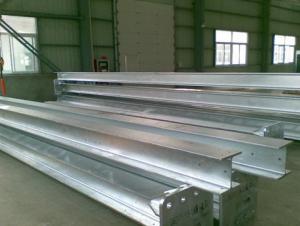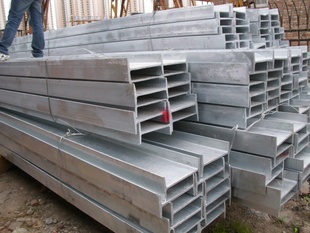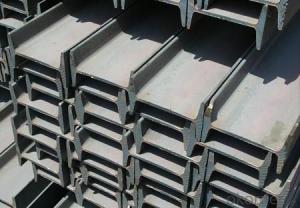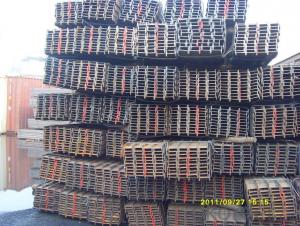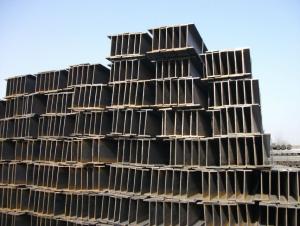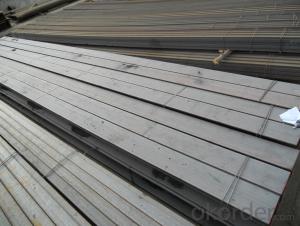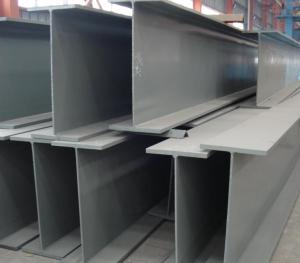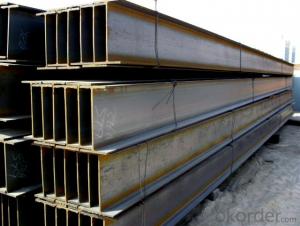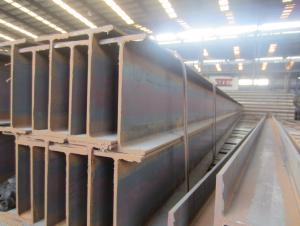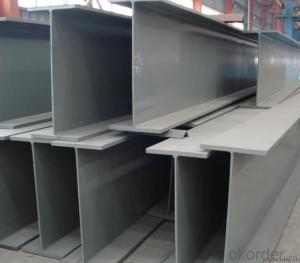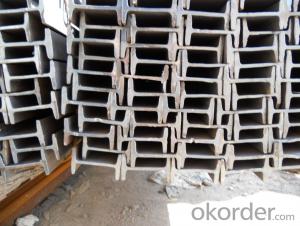Galvanized H Beam
- Loading Port:
- China Main Port
- Payment Terms:
- TT OR LC
- Min Order Qty:
- -
- Supply Capability:
- 5000 m.t./month
OKorder Service Pledge
OKorder Financial Service
You Might Also Like
Product Description:
Specifications of Galvanized H beam
1. Invoicing on theoretical weight or actual weight as customer request
2. Length: 6m, 12m as following table
3. Sizes:Zinc Thickness :15-80μ
(1).used for the plant, high-rise building construction
(2).used for the bridge, shipment building
(3).used for lifting and transportation machinery, equipment manufacturing base building
(4).used for the support, foundation pile manufacturing
Packaging & Delivery of Galvanized H beam
1. Packing: it is nude packed in bundles by steel wire rod
2. Bundle weight: not more than 3.5MT for bulk vessel; less than 3 MT for container load
3. Marks:
Color marking: There will be color marking on both end of the bundle for the cargo delivered by bulk vessel. That makes it easily to distinguish at the destination port.
Tag mark: there will be tag mark tied up on the bundles. The information usually including supplier logo and name, product name, made in
If loading by container the marking is not needed, but we will prepare it as customer request.
4.Transportation: the goods are delivered by truck from mill to loading port, the maximum quantity can be loaded is around 40MTs by each truck. If the order quantity cannot reach the full truck loaded, the transportation cost per ton will be little higher than full load.
5. Delivered by container or bulk vessel
Further performance and design information for galvanizing can be found in BS EN ISO 14713-1 AND BS EN ISO 14713-2. The durability performance of a galvanized coating depends solely on the corrosion rate of the environment in which it is placed. Corrosion rates for different environments can be found in BS EN ISO 14713-1 where typical corrosion rates are given with a description of the environment in which the steel would be used.
The process of hot-dip galvanizing results in a metallurgical bond between zinc and steel with a series of distinct iron-zinc alloys. The resulting coated steel can be used in much the same way as uncoated.
A typical hot-dip galvanizing line operates as follows:
Steel is cleaned using a caustic solution. This removes oil/grease, dirt, and paint.
The caustic cleaning solution is rinsed off.
The steel is pickled in an acidic solution to remove mill scale.
The pickling solution is rinsed off.
A flux, often zinc ammonium chloride is applied to the steel to inhibit oxidation of the cleaned surface upon exposure to air. The flux is allowed to dry on the steel and aids in the process of the liquid zinc wetting and adhering to the steel.
The steel is dipped into the molten zinc bath and held there until the temperature of the steel equilibrates with that of the bath.
The steel is cooled in a quench tank to reduce its temperature and inhibit undesirable reactions of the newly formed coating with the atmosphere
- Q: What are the environmental impacts of steel H-beams?
- Steel H-beams have several environmental impacts, including the extraction and processing of raw materials, such as iron ore and coal, which contribute to air and water pollution. The manufacturing process also requires a significant amount of energy, resulting in greenhouse gas emissions. Additionally, the transportation and installation of steel H-beams contribute to carbon emissions. However, steel H-beams are durable and long-lasting, which can offset some of their environmental impacts by reducing the need for frequent replacements.
- Q: How do steel H-beams perform in coastal areas?
- When constructing in coastal areas, steel H-beams are often chosen due to their durability and reliability. The coastal environment poses challenges like high humidity, exposure to saltwater, and strong winds, which can hasten corrosion and structural degradation. Nevertheless, steel H-beams are specifically engineered to withstand these conditions. One of the main advantages of steel H-beams in coastal areas is their exceptional resistance to corrosion. Most steel H-beams are manufactured using carbon steel and are coated with protective materials like galvanization or epoxy paint. These coatings create a barrier that prevents moisture and saltwater from reaching the steel and causing corrosion. Additionally, the structural design of H-beams, with their wide flanges and deep web, offers remarkable strength and stability against wind and waves. Furthermore, steel H-beams have a lengthy lifespan and require minimal maintenance in coastal areas. The protective coatings, combined with the inherent strength of steel, ensure that these beams can endure the harsh coastal environment for many years without significant deterioration. Regular inspection and maintenance of the coatings can further extend their lifespan. However, it is important to acknowledge that the performance of steel H-beams in coastal areas can be influenced by various factors. The precise location, proximity to the shoreline, exposure to salt spray, and prevailing wind conditions can all impact the performance and longevity of steel H-beams. Therefore, it is crucial to consult with structural engineers and adhere to proper design and construction practices to guarantee optimal performance of steel H-beams in coastal areas.
- Q: Can steel H-beams be used in museum and art gallery construction?
- Yes, steel H-beams can be used in museum and art gallery construction. Steel H-beams are commonly used as structural elements in building construction due to their strength and durability. They provide excellent support for large spans and heavy loads, making them suitable for creating expansive and open exhibition spaces in museums and art galleries.
- Q: What are the different types of steel H-beam connections used in industrial facilities?
- Industrial facilities commonly use several different types of steel H-beam connections to provide structural stability and support in large-scale construction projects. The following are some frequently used types: 1. The most commonly used type is welded connections. These involve welding the H-beams together at the joint, creating a strong and rigid connection. Welded connections are known for their high strength and durability, making them suitable for heavy-duty applications. 2. Bolted connections involve securing the H-beams together using bolts and nuts. They can be easily disassembled and reassembled, making them ideal for situations where flexibility and future modifications are required. However, they may not be as strong as welded connections. 3. Riveted connections are an older method that uses metal rivets to join the beams together. They have been largely replaced by welded and bolted connections due to their higher cost and time-consuming installation process. However, they are still used in some historical or heritage structures. 4. Moment connections, also known as rigid connections, are designed to resist bending moments and provide greater stability. Additional plates are welded or bolted to the beam ends, creating a stiffer connection that can resist rotational forces. 5. Pinned connections allow for rotation between the beams, providing flexibility in the structure. They are commonly used in structures where movement or deflection is expected, such as bridges or earthquake-resistant buildings. Pinned connections can be achieved through the use of specialized pins or bearings. 6. Shear connections transfer shear forces between the beams. They are typically made through the use of bolts or welding additional plates to the beam ends. Shear connections are crucial for ensuring the structural integrity of the H-beam system during lateral loads or vibrations. It is important to consider factors such as load-bearing requirements, structural design, project specifications, and cost when selecting the appropriate H-beam connection type. Consulting with a structural engineer or construction professional is recommended to determine the most suitable connection type for a specific industrial facility.
- Q: How do steel H-beams resist lateral forces?
- The structural shape and material properties of steel H-beams enable them to withstand lateral forces. The H-beam shape effectively distributes the load along its entire length, thereby offering excellent resistance against lateral forces. The horizontal flanges of the H-beam are designed to withstand bending and torsion, while the vertical web connects and stabilizes the flanges, preventing them from buckling when subjected to lateral loads. Moreover, the material properties of steel significantly contribute to the H-beam's ability to resist lateral forces. Steel is renowned for its high strength and stiffness, making it an ideal choice for structural applications. The strength of steel allows H-beams to endure substantial forces without any deformation or failure. Additionally, the stiffness of steel helps to maintain the beam's shape and prevent excessive deflection under lateral loads. Furthermore, H-beams can be further reinforced with additional bracing or connections to enhance their resistance against lateral forces. These reinforcements play a crucial role in distributing the lateral loads more evenly and improving the overall stability of the structure. To sum up, the resistance of steel H-beams against lateral forces is achieved through their specific structural shape, material properties, and the possibility of incorporating reinforcements. The H-beam shape effectively distributes the load, while the strength and stiffness of steel provide the necessary resistance against lateral forces.
- Q: Can steel H-beams be used for supporting water treatment plants?
- Yes, steel H-beams can be used for supporting water treatment plants. Steel H-beams are commonly used in construction due to their strength and durability. They provide excellent load-bearing capacity and can withstand the weight and pressure exerted by the various components of a water treatment plant, such as tanks, pipes, and equipment. Additionally, steel H-beams can be easily fabricated and customized to meet the specific requirements of the water treatment plant, ensuring a stable and reliable support structure.
- Q: How do steel H-beams perform in areas with high humidity?
- Steel H-beams are renowned for their remarkable strength and durability, making them a favored option for diverse construction projects. In terms of regions with elevated humidity levels, steel H-beams exhibit exceptional performance. One of the primary merits of steel lies in its ability to resist moisture and corrosion. Usually, steel H-beams are coated with protective finishes or galvanized to enhance their resistance against rust and corrosion. These coatings function as a barrier, preventing moisture from infiltrating the beam's surface and causing harm. High humidity can result in the accumulation of moisture in the atmosphere, which may potentially inflict structural damage on specific materials. However, steel H-beams are immune to this issue. Their sturdy construction and corrosion-resistant coatings ensure their ability to withstand the challenges posed by humid environments. Furthermore, steel H-beams possess excellent load-bearing capabilities, which are vital for areas characterized by high humidity. Moisture in the atmosphere can sometimes weaken certain materials, compromising their structural integrity. Nonetheless, steel H-beams retain their strength and stability, even in humid conditions. It is important to note that regular maintenance and inspections are still necessary to ensure the long-term performance of steel H-beams in high humidity areas. This includes conducting routine checks for any signs of corrosion or damage to the protective coatings. By promptly addressing any emerging issues, the lifespan and performance of the steel H-beams can be maximized. In conclusion, steel H-beams are a dependable choice for areas with high humidity due to their resistance to moisture, corrosion, and their excellent load-bearing capabilities. With proper maintenance, these beams can provide enduring structural support, even in challenging environmental conditions.
- Q: What's the difference between welded H - section steel and high frequency welded H - section steel and hot rolled H section steel?
- Specification and material. When the hot-rolled H steel can fully replace welding of H steel, and the former than the latter to ensure quality. In general, in the structural design of high-rise buildings, should adopt the hot-rolled H steel, steel portal frame of light steel plant, selection of welding H steel with variable cross-section steel index is better, but the project cost can not save much, the reason is that the processing capacity of hot-rolled H steel is smaller, shorter duration, if the calculation of the comprehensive economic benefits (including the project put into use), play a decisive role in the period under the condition of optional hot-rolled H steel, but when the time limit for not strict or some image project, is in line with the principle of conservation of resources selection of welding H steel.
- Q: Can steel H-beams be used for supporting greenhouses or agricultural tunnels?
- Steel H-beams are a suitable choice for supporting greenhouses or agricultural tunnels due to their strength and durability. The H-beams' reputation for robustness makes them an ideal option for structures that require long spans and can bear heavy loads. Given that greenhouses and agricultural tunnels must withstand the weight of the structure itself, as well as equipment, plants, and potential weather conditions such as snow loads or wind gusts, the strength and stability provided by steel H-beams are essential for ensuring the longevity and safety of these structures. Moreover, steel is resistant to pests, rot, and decay, rendering it a suitable material for agricultural applications.
- Q: How do steel H-beams contribute to the overall cost-effectiveness of a project?
- Steel H-beams contribute to the overall cost-effectiveness of a project by providing a strong and durable structural support system. Their high strength-to-weight ratio allows for the use of fewer materials, reducing construction costs. Additionally, their versatility and ease of installation result in reduced labor expenses. Moreover, steel H-beams require minimal maintenance and have a longer lifespan, resulting in long-term cost savings.
Send your message to us
Galvanized H Beam
- Loading Port:
- China Main Port
- Payment Terms:
- TT OR LC
- Min Order Qty:
- -
- Supply Capability:
- 5000 m.t./month
OKorder Service Pledge
OKorder Financial Service
Similar products
Hot products
Hot Searches
Related keywords
